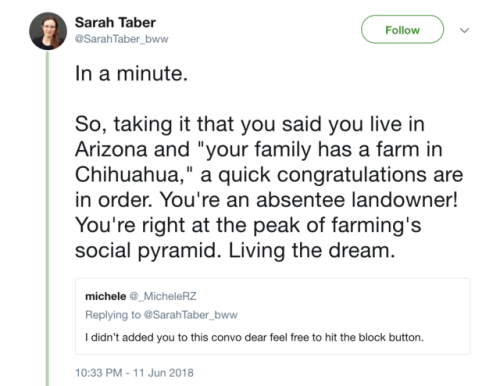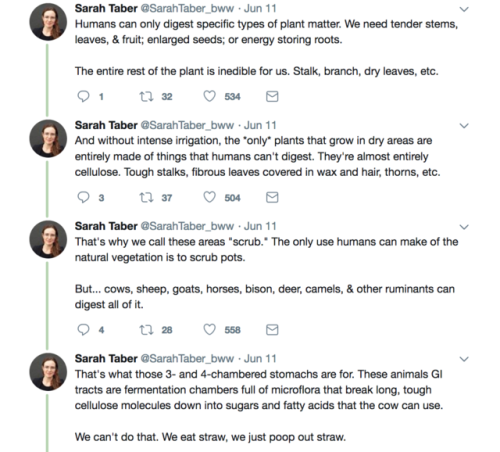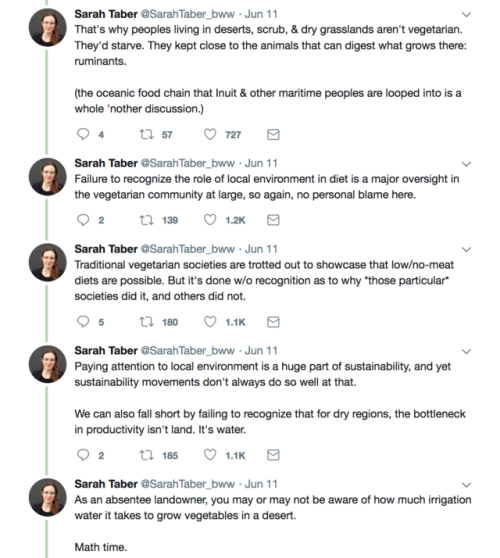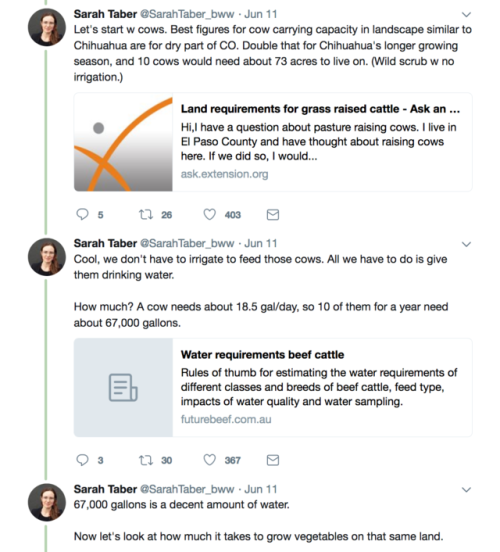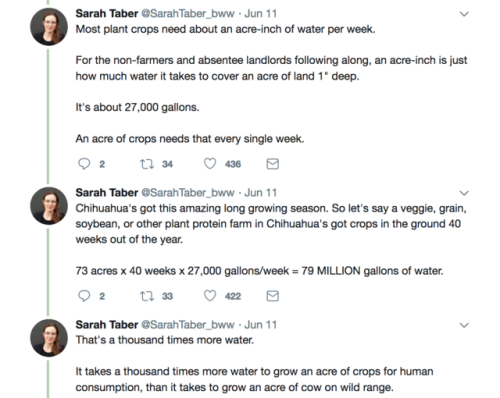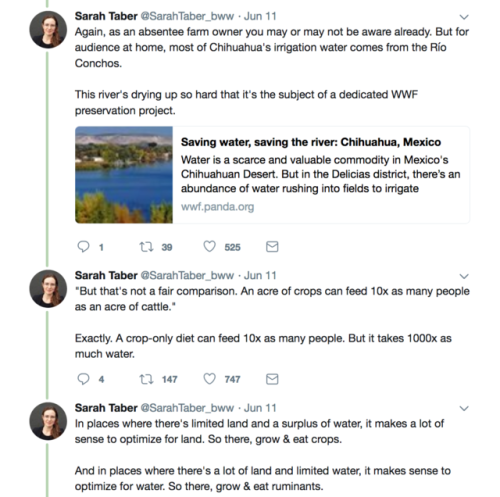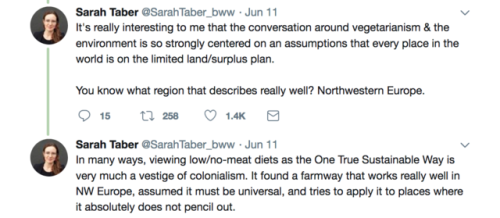plantyhamchuk:kawuli:This person is my new best friendFarming systems need to fit into their natural
plantyhamchuk:kawuli:This person is my new best friendFarming systems need to fit into their natural and social environment. Sometimes we describe this as a socio-ecological niche.Like I’m seeing this going around on my dash a lot but it really leaves out some key info. And yes I’m gonna talk about animal husbandry, but really it’s about how people are shitty at managing resources, especially - you guessed it - SOIL.Sources are at the bottom for further reading.Semi-arid regions are fragile, ecologically speaking. And the dirty thing about animal husbandry is how rampant overgrazing is. Now add into the fact that Chihuahua has had multiple serious droughts, and guess what farmers desperate to keep their herds healthy (or even merely alive) will do, they will overgraze even more rampantly, hurting the lands even more. They will graze the plants until there is nothing left, and then you have soil erosion and degradation - now the soil will have a harder time supporting plants that everyone depends on for the survival in one form or another. People want to act like there’s no ecological consequences to raising animals, but those people have never looked at a pig sty.Don’t take it just from me, here’s an excerpt from a study on the ecological impacts of the beef industry in Chihuahua: “Deferring, limiting, or avoidingdefoliation of native grasses during the postreproductivestage until dormancy allows for tiller recruitment plus energystorage necessary for overwintering and regrowth the followinggrowing season. Failure to apply basic range managementpractices during the recent drought cycle is a likelyreason for the dramatic changes in Chihuahua’s rangelands.For example, in semiarid and arid ecosystems it is evidentthat mesquite and creosote bush have expanded into areasthat were grasslands prior to the drought beginning in 1992.Annual grasses and forbs with low forage value have replacedperennial grasses within many of these ecosystems. A reductionin perennial grass crown cover and presence of largepatches of dead plants is a common occurrence. Consequently,lack of soil cover accelerates soil erosion by convectionalthunderstorms (high intensive rainstorms) typical of thisregion, and strong winds that occur during the autumn andearly spring. Cattle tracks become deep gullies and duststorms increase its frequency and intensity.“So yeah, I don’t care about your fantasy or ideal of animal husbandry. On the ground practices are currently tearing up this planet. Practices that benefit the rich (by exploiting the environment, to make money to please taste buds) while further eroding the land. Lessening the land’s ability to support life.From the same study:“The damage to soil, vegetation, and ecosystem processesare easily seen on most of Chihuahua’s rangelands. It isthe result of cumulative effects resulting from a decade ofdrought and improper grazing that has lessened the potentialof rangelands to support livestock and wildlife over thelong-term. “She says that we don’t have to irrigate animal feed, but, as the current system in place… it does. It does irrigate animal feed, or uses water from aquifers that are replenished not on a human timescale, so we’re effectively draining ancient nonrenewable sources of clean water. And if there isn’t animal feed available locally, it is brought in from other places, places where in effect water is exported to be used for animal feed. That’s speaking overall. In Chihuahua they have to drill their wells deeper and deeper merely to supply enough water for the animals.Animal husbandry in Chihuahua as currently practiced is for export to American markets. They don’t have enough rainfall for the irrigated animal feed, so what they do is run cow calf operations, where they overstock animals and degrade the land - and then auction the (still young) animals off to be finished at giant CAFO lots in America. The Mexican farmers don’t sell locally because they can make more money this way, and also the giant agribusinesses in American can handle large quantities of animals.Indigenous people of the region never raised and ate beef back in the day. Those animals didn’t exist there. Beef, and the type of resource intensive animal husbandry surrounding it, are colonialism. You know what animals they ate in pre-colonial Mexico? Wild turkey. Iguanas. Turtle eggs. Beetles. Those are the indigenous creatures of the land, the creatures that the land would and could reliably support, even with periods of drought The people also ate many many fruits and vegetables from the land, and yes traditionally there was enough rain to grow corn and beans in Chihuahua. There are live oaks in the Chihuahuan desert, and indigenous people ground the acorns into flour. Honey mesquite trees are also native there and have edible bean pods and foliage. Prickly pear is edible, creosote bush was used for a tea, sunflowers are edible, yucca stalks are edible, pinyon pine cones are edible, tomatillos are edible.. you get the idea. Lorena Ramírez, ultramarathon runner Speaking of indigenous, there is a tribe called the Rarámuri or Tarahumara, who continue to live a very traditional lifestyle. Of note, only 5% of their diet comes from meat. They have intensive knowledge of local plants and are perhaps best known for winning marathons.ChihuahuaThis is what happens with animal husbandry all over the world. It seems great until you have a drought, the animals strip the land bare, the animals die and the land - devoid of natural, protective cover - also dies. There’s no resilience, no slack in the system left.The same thing happens when you till the soil. I know that no one really wants to read or hear about this stuff, but yeah raising animals in arid or semi-arid areas is a really bad idea in most parts of the world. It’s the same as overfishing or farmers tilling the land too much. People get greedy, or just misjudge what the planet can handle, or invest in a particular way of life and then natural droughts or fluctuations happens and then everything falls apart.(some) Sources:https://journals.uair.arizona.edu/index.php/rangelands/article/download/15859/15838 - Chihuahua’s Cattle Industryand a Decade of Drought:Economical and EcologicalImplicationshttps://en.wikipedia.org/wiki/Cow-calf_operationhttp://aces.nmsu.edu/pubs/research/economics/BL794/welcome.html - Results of a Survey of Cattle Exporters in Chihuahua, Mexico¹https://www.nps.gov/cham/learn/nature/upload/trees_6_30_09.pdfhttp://www.foragingtexas.com/2008/10/honey-mesquite.htmlhttps://en.wikipedia.org/wiki/Mexican_cuisinehttp://pulitzercenter.org/reporting/chihuahua-where-rain-doesnt-fall-any-morehttp://wtufc.org/downloads/EdiblePlantsWildResourcesCD-KathBrooks_UofA.pdfhttps://www.nativeseeds.org/learn/seed-diaries/366-tepehuan-tomatillohttps://en.wikipedia.org/wiki/Rar%C3%A1murihttps://pdfs.semanticscholar.org/d801/c635ca282d070d2a728c51b3d3af90a9b91c.pdf - Traditional Ecological Knowledge andPractice for Edible Wild Plants:Biodiversity Use by the Raramuri in theSierra Tarahumara, Mexico -- source link
Tumblr Blog : kawuli.tumblr.com
#chihuahua#mexico#animal husbandry#ecology#tarahumara
